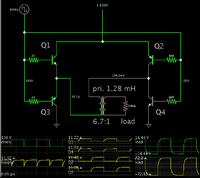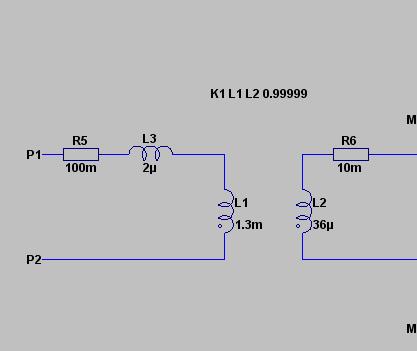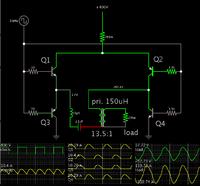andrew06
Newbie level 4
I am designing a 100 VDC to 14 volts VDC isolated converter, 70 Amps output.
I will use a full bridge, with one single winding also on secondary side.
Max Duty cycle is 0.45
Core is a TX58 toroid with Al= 2100 nH per turn and Surface= 152 mm²
Bsat=0.15 T
PWM frequency is 40 KHz generated by a good old TL494 (Ct= 1nf Rt= 14K)
I did a preliminary calc to know the primary number of turns:
Nprimary= (Primary voltage * Duty *1000000) /(2* Frequency *Bmax * Surface)
Nprimary= 24.7 turns
Assuming a 1.4 voltage drop on the secondary rectifier, Turns ratio should be close to 100/(14 + 1.4)= 6.5
The Primary current drawn should be close to 70*14/100= 9.8 Amps
Now, the problem come when I calculate the inductance of the primary winding
Lp= Np turns x Np turns x Al
Lp= 24.7 x 24.7 x 2.1= 1281 uH
1281 uH at 40 KHz is quite a big impedance and my SMPS may not work :
So, I did not understood how to deal with this.
I have tried many variations with changing frequency, forcing number of turns, changing also core / material without proper results.
Any help should be really appreciated
Kangoo
I will use a full bridge, with one single winding also on secondary side.
Max Duty cycle is 0.45
Core is a TX58 toroid with Al= 2100 nH per turn and Surface= 152 mm²
Bsat=0.15 T
PWM frequency is 40 KHz generated by a good old TL494 (Ct= 1nf Rt= 14K)
I did a preliminary calc to know the primary number of turns:
Nprimary= (Primary voltage * Duty *1000000) /(2* Frequency *Bmax * Surface)
Nprimary= 24.7 turns
Assuming a 1.4 voltage drop on the secondary rectifier, Turns ratio should be close to 100/(14 + 1.4)= 6.5
The Primary current drawn should be close to 70*14/100= 9.8 Amps
Now, the problem come when I calculate the inductance of the primary winding
Lp= Np turns x Np turns x Al
Lp= 24.7 x 24.7 x 2.1= 1281 uH
1281 uH at 40 KHz is quite a big impedance and my SMPS may not work :
So, I did not understood how to deal with this.
I have tried many variations with changing frequency, forcing number of turns, changing also core / material without proper results.
Any help should be really appreciated
Kangoo


